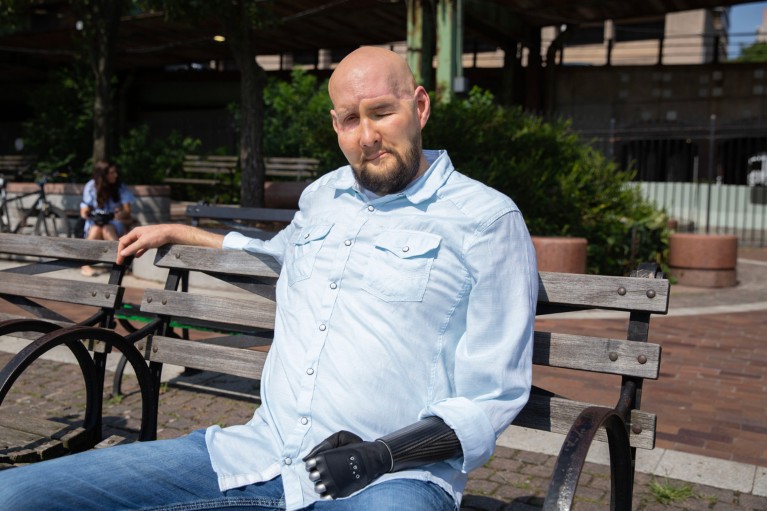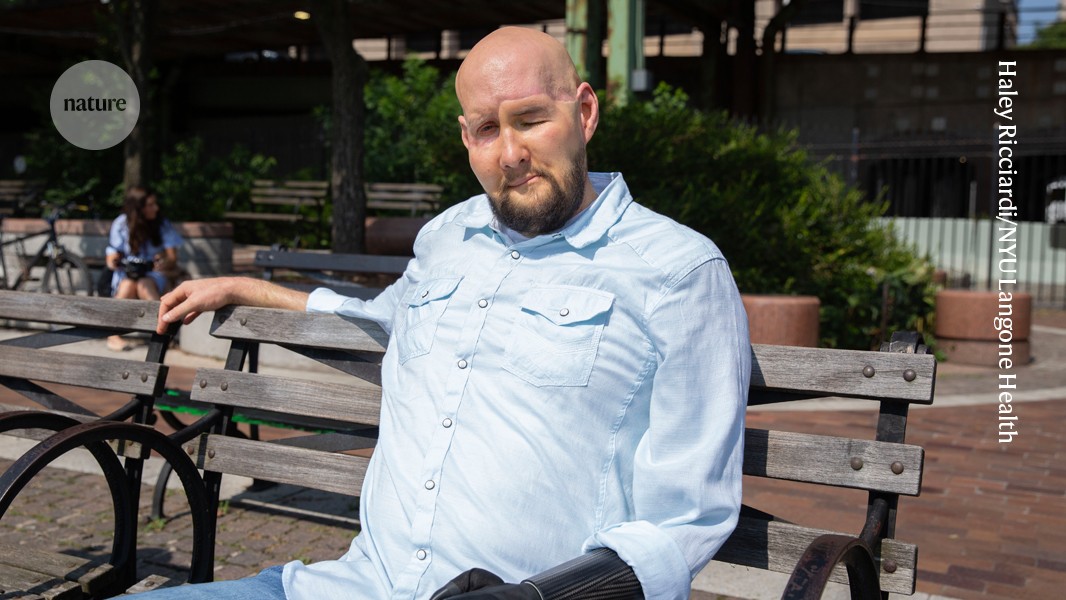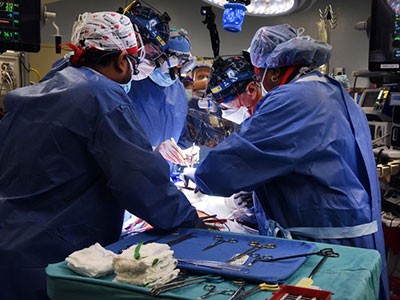
Aaron James now has one blue eye and one brown — the former his own, the latter from an unprecedented whole-eye transplant.Credit: Haley Ricciardi/NYU Langone Health
For Aaron James, it still hasn’t quite sunk in that he received the first successful whole-eye transplant in history. “It just blows my mind being a part of something this big,” says the 47-year-old father from Hot Springs, Arkansas.
In 2021, James was injured in an electrical accident while working as a high-voltage lineman. He lost his dominant left arm, left eye, chin and nose. For two years, he was unable to eat solid food, taste, smell or talk normally.
In May 2023, he received the first whole-eye and face transplant at New York University (NYU) Langone Health in New York City. More than a year after the surgery, his transplanted eye remains healthy — the retina can even respond to light — but James cannot see out of it.
“It is a technically brilliant operation,” says surgeon Bohdan Pomahač at Yale School of Medicine in New Haven, Connecticut, who in 2011 performed the first full facial transplant in the United States, but was not involved with James’s case. “The authors pushed the boundaries of innovation.” The surgery is described today in JAMA1.
Marathon surgery
A large medical team transplanted the whole left eye, the bony socket around it, the nose, a piece of chin bone and the associated muscles, nerves and blood vessels to James from a donor whose brain showed no functional activity. The surgery took about 21 hours.
First pig-to-human heart transplant: what can scientists learn?
Doctors never expected James to regain sight in the transplanted eye, says Daniel Ceradini, a surgeon at NYU Langone Health and first author of the study. That’s because there was no evidence that the donor’s optic nerve could successfully reconnect to James’s brain. The optic nerve, which sends information from the retina to the brain, is part of the central nervous system, and how to regenerate that system is a mystery. But the operation does take researchers a step closer to an eye transplant that could one day restore vision, which, Ceradini says, has been “considered a holy grail”.
James needed a face transplant and was willing to take on the extra risk associated with an attempted eye transplant in return for helping future transplant recipients. “I was already going to be on immunosuppressants from the face transplant,” he says. “All we could do was gain something.”
Practice, practice
Surgical dissection of the eye is so complex that the team practiced at least 15 times on cadavers, says Ceradini.
Many scientific advances came together to make the surgery happen. The team “essentially developed a new operation based on existing principles”, says Pomahač. The blood supply to the eyes is from a different artery from that supplying the rest of the face. To ensure that the donated eye didn’t lose blood flow for too long, the surgeons connected the artery that supplied the donor’s eye to a branch of the donor’s external carotid artery, a large vessel that starts near the neck. The whole assembly was then transplanted into James, a procedure that has never been achieved in humans . “They figured out how to recover an eyeball so that it doesn’t damage the blood flow,” says Pomahač.
Another advance was the creation of a pair of 3D-printed surgical guides that allowed the surgeons to take precisely the right amount of donor bone needed to fit James’s face. The guides were based on computed tomography scans of the donor’s and James’s faces, and were fitted over their faces during surgery. “The donor piece fits right in there, like a snap-fit puzzle piece,” says Ceradini.
After all this, no one knew how the transplanted eyeball would behave, says Ceradini: “Does it shrink? Does the retina work?”
An itching sensation
When James awoke from surgery, the first thing he noticed was the smell. After two years with no sense of smell, he was grateful, even though the odour was “hospital”, he says, laughing.
Rat neurons repair mouse brains — and restore sense of smell
After about a week and a half, he saw his new face for the first time. Even now, when he passes a mirror, he will gaze, captivated. He no longer wears an eye patch and mask when he goes out, as he did before the transplant. He is thrilled to be able to grow a beard again.
The transplanted eye cannot move or see, but it has normal pressure and good blood flow, and the retina responds to light. James can feel a sensation of itching deep in the eye socket, and feeling around the eye has started to come back. The peripheral nerves around the eye regrow rather randomly, Ceradini says.
Restoring vision
It is unclear whether an eye transplant in which the recipient regains vision will one day be feasible. Ceradini thinks it is “an achievable goal in the near future”. Pomahač disagrees. Both do agree, however, that the key missing piece to achieving it is working out how to regenerate the optic nerve. Pomahač thinks that this is unlikely to be possible. “It may happen if we figure out brain or spinal-cord regeneration,” he says.
Nonetheless, James, his wife Meagan and their 19-year-old daughter Allie are in good spirits, which for them means teasing each other. Allie recently posted on TikTok, rating things her dad has done, Meaghan recalls. “100/10, made medical history,” Allie posted. “Still bald headed, tho.”




